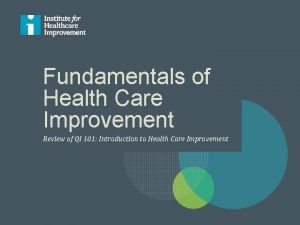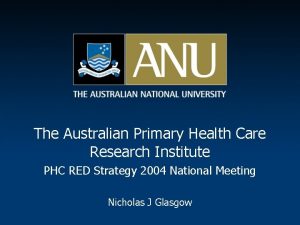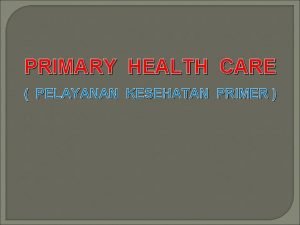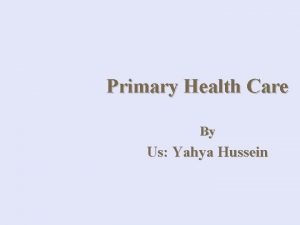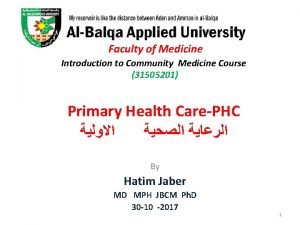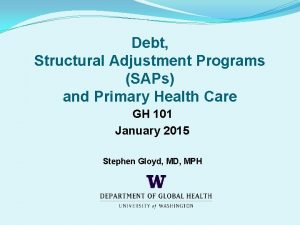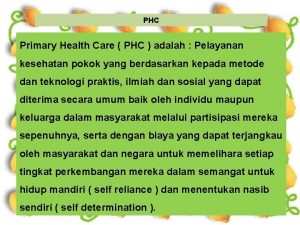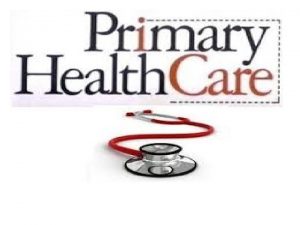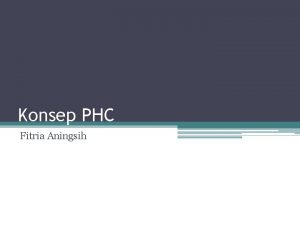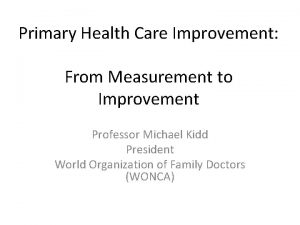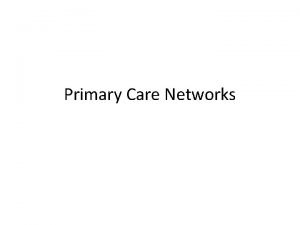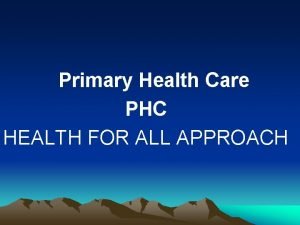Supporting measurement improvement of primary health care PHC











- Slides: 11

Supporting measurement & improvement of primary health care (PHC) at the facility and community levels Dr. Jennifer Adams, Deputy Assistant Administrator, Bureau for Global Health, USAID

Global and bilateral mechanisms are improving primary health care through: • Financial protection: Reducing financial barriers to access essential life-saving services for the poor • Essential services: Improving quality of care and scaling up coordinated delivery of essential, evidenced-based services; • Population coverage: Ensuring that poor, underserved, marginalized and vulnerable populations have equitable access to essential health services • Responsiveness: Assuring the dignity, confidentiality, autonomy, quality and timeliness of services for poor and marginalized populations

Facility teams independently monitor indicators

Acting on the Call: Ending Preventable Child and Maternal Deaths (EPCMD) • 24 priority countries • 2. 5 million more children surviving • 200, 000 maternal deaths averted

Ending Preventable Child and Maternal Deaths (EPCMD) Roadmap to 2020 Annual Reporting Annualized Cycle of Planning and Field Support Reporting Progress Through Acting On the Call Leadership Planning Target Setting Single Roadmap Now Guiding USAID Efforts EPCMD management dashboards and reviews Strengthening prioritization and transparency of goals and targetsetting for aligned action Operationalizing field support through mission visits to strengthen design efforts and HIP/ OP development Dashboar d PPR & HIP Nov: Dashboards completed by 24 priority Missions Jan: PPR Reviews & HIP Guidance Released Q 1 Acting on the Call Report HIP June, July & Aug: EPCMD Review of 24 Priority HIPs April 30: Draft of Ao. TC report, Dashboard Check in; May: Finalize Report Q 2 PPR & HIP Mission Visits Oct: PPR Guidance Released and Draft technical considerations for HIP; Dec: PPR Due Jan & Feb: Mission Visits to support writing the HIP Q 3 Q 4 Acting on the Call Ministeri al Meeting Dashbo ard Updated Dashboard for FY 16 June: Annual Meeting Institutionalizing a culture of transparency / visibility through annual performance reporting Setting activity targets and improving tools to track progress and technical / leadership capabilities 5

USAID Missions’ Investments in Newborn Health in EPCMD countries

Improving and advancing measurement of health systems to improve PHC Tools under development: • Developing rapid assessment tool for checking quality of medicines to reduce use of poor quality medicine • Promoting global benchmarking of health system functions and performance through a health system benckmarking tool to monitor performance • Developing tool for better analysis of DHIS data for measuring health system performance and its correlates

The Community Health Framework WHY should we care about community health? Community health is foundational to attaining many of the SDGs. WHAT is needed to create a strong community health ecosystem? An ecosystem of heath specific and health enabling actors and structures, both formal and informal, working together and supported by the agency, access, and resources needed to ensure the health of community members: • Agency, e. g. , awareness of needs, empowerment, and incentives to act; • Access, e. g. , access to care, access to referral systems; and, • Resources, e. g. , financial resources, medical suppliers. DISTRICT / NATIONAL LOCAL COMMUNITY HOME HEALTH SPECIFIC COMPONENTS DISTRICT & NATIONAL CARE COMMUNITY LEVEL CARE HOME LEVEL PROVIDERS COMMUNITY MEMBERS FAMILY MEMBERS LOCAL COMMUNITY DISTRICT & NATIONAL COMMUNITY HEALTH ENABLING COMPONENTS AGENCY ACCESS RESOURCES HOW can we take action to strengthen community health ecosystems? A five step process can help leaders bring the right data to bear for decision making, and set up sustainable community health programs with clear accountability. WHERE can we find examples of effective models and innovations for community health? This framework includes a library of existing models across each component of community health as well as detailed case studies. SET TARGET OUTCOMES UNDERSTAND EXISTING COMPONENTS ANALYZE BOTTLENECKS DEVELOP OR STRENGTHEN PROGRAMS IMPLEMENT, MONITOR & EVALUATE TOOLKIT 8

This framework has been developed to support decision makers in answering key questions about community health The community health framework is intended to support Ministries of Health in developing and strengthening programs for improved community health outcomes. The intention is for USAID missions and other advisors to use the framework to structure a dialogue, develop recommendations, and foster continuous learning with Ministries of Health. The community health framework does… • Bring together a wealth of existing knowledge and models that articulate components of community health • Provide a flexible framework for national level diagnosis of needs and planning of actions • • Enable a long-term view to planning and developing strong community health outcomes Allow for a “common language” with a classification of interventions and tools and the creation of a living and growing toolbox The community health framework does not… • Serve as a strategy or action plan with specific programs, targets, or budgets • Seek to provide a one size fits all view on community health structures, programs, or interventions • Represent an exhaustive list of actors, needs, or opportunities • Prescribe an impact measurement or continuous learning agenda for countries and programs In the process of developing this framework, over 60 community health experts were interviewed and over 70 academic articles, reports, and evaluations were reviewed. 9

Measurement for health summit June 2015 Consensus • Agree on priority actions required to build robust systems for monitoring SDGs and national priorities • Address challenges facing countries (fragmentation, disjointed efforts etc. ) Deliverables • Common Roadmap and 5 -Point Call to Action: • Increase level and efficiency of investments • Strengthen country statistical capacity • Ensure well functioning population health data • Improve open facility and community systems and disease surveillance and admin data • Enhance use and accountability A way forward • Greater partner collaboration and joint action • Align and meet country health priorities

Thank you 11
 Level of care primary secondary tertiary
Level of care primary secondary tertiary Qi 101: introduction to health care improvement
Qi 101: introduction to health care improvement What cannot be measured cannot be improved
What cannot be measured cannot be improved Uccs primary care clinic
Uccs primary care clinic Australian primary health care research institute
Australian primary health care research institute Konsep primary health care
Konsep primary health care Dr. kanupriya chaturvedi
Dr. kanupriya chaturvedi Alma hussein 28
Alma hussein 28 Defination of phc
Defination of phc Concepts of primary health care
Concepts of primary health care Principles of primary health care
Principles of primary health care Structural adjustment programs
Structural adjustment programs

